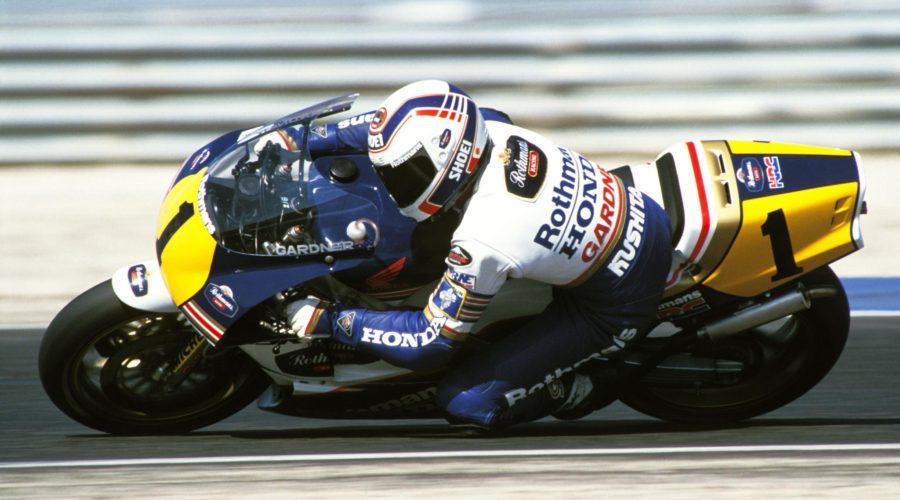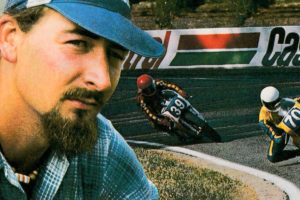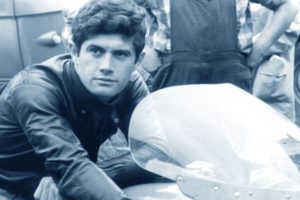The Wayne Train
Mick Doohan won more titles, and Casey Stoner was pure speed, but no Australian racer lit up the country like Wayne Gardner, the Wollongong Whizz. Two Wheels Editor Mick Matheson and racing writer Don Cox paid this tribute to the great man on his retirement in 1992.
In the month since Wayne retired, I’ve watched – for the umpteenth time – my prized videos of the two greatest GPs ever.
The 1989 and 1990 Australian GPs at Phillip Island are, in my humble, Aussie-biased opinion, simply the most outstanding races I’ve seen. And that’s because of one man, Wayne Gardner.
Gardner wasn’t the only bloke with a sudden attack of smoke in the eyes on that day in ’89. I remember jumping out of my chair and yelling at the top of my voice as he crossed the line to take his victory, oblivious to the half-dozen mates in the room doing the same. The tension in the air, which built to bursting point right through the race, expended itself in an uncontrolled orgy of celebration. Then suddenly we looked at each other and got very self-conscious, turning around to discreetly wipe away the tears of pride before anyone could accuse us of being sissies …
I still get caught up in the emotion of that race. It had the lot – but if I need to recount the details, go and find a copy to watch yourself because that’s the only way to really experience the effect it has. I save the video for special occasions, when I know I won’t be interrupted, when I need a hit of intense racing, when I know no-one will notice the red eyes afterward.
In 1990 I immersed myself in the whole Phillip Island mystique. The ride to Mecca, bikes everywhere, excitement growing. The Island atmosphere was like a drug and I was hooked.

The high peaked in the race. Gardner was up there, running hard and promising another win. You could feel the will of the crowd supporting him.
But he nearly lost it in the hairpin and was way behind. We could see his fairing crashing loose under the bike, beating into the ground when he heeled over into a corner. Suddenly it seemed Gardner might not win. It couldn’t be.
For a while the feeling was bad but Mick Doohan took up the Aussie colours and battled for the lead with those Yank fellas. It still looked good for Australia.
When we gradually realised Gardner was catching the leaders – by now well ahead – the power of the crowd’s emotion was tangible. Wayne was coming back!
And he kept doing it. Against the odds he put his head down and reached into the depths of the famous Gardner courage and determination and carved a way through the competition. He took the lead and we yelled and jumped and urged him on. More tears of pride.
Mick Doohan’s win at Eastern Creek this year filled us with pride. And I don’t know about you, but I felt for his loss of the world title. You can’t deny Rainey deserved the crown in the end but even in the GP circus the feeling is that Doohan deserved it as much, if not more.
But next year’s the time to worry about that. Then Mick’ll show ’em.
Meanwhile, we’ve got another hit of nationalistic revelry coming up in a few days, and another shot at that miracle of motorcycling they call Phillip Island.
This weekend Robbie Phillis and a host of our brilliant Superbike racers are going to do battle with the rest of the world Superbike crowd. Next weekend they’re in NZ for more of the same.
More than just the Aussies, there are the gloriously booming Ducati 888s to blow our minds and set the ground shaking beneath us. With the incredible closeness of this year’s Superbike racing and the flowing speed of Phillip Island it is, without doubt, going to be some of the most incredible racing we’ll ever see.
But do you know what? Ten years ago I wasn’t all that excited about racing. For a start we didn’t have world championship events and international-status heroes as now. And, maybe because of that, my motorcycling was more of a personal, in the saddle thing.
One man changed all that for ever. Thank you, Wayne Gardner. Thank you for giving so much to us everyday motorcyclists.
By Mick Matheson, Two Wheels November 1992.

Wayne Michael Gardner is arguably the most significant figure in the 92-year history of Australian motorcycle racing.
Gardner’s legacy for Australian motorcycle sport has been profound, in the things that happened around his exploits as well as the things he did. Consider two landmark developments that Gardner’s successes triggered.
One was the televising of GP races in Australia. The second was the reality of an Australian world championship GP, for which Gardner was clearly the promoter’s key drawcard.
Gardner was 35 days short of his 33rd birthday when he finished second and set the fastest lap time in his last motorcycle GP at Kyalami, South Africa, on September 6. He’d raced bikes half his life, and not without cost.
Gardner lived through a nightmare GP debut, with a collision at Assen in 1983 with Franco Uncini. And by the end of his career he had a heap of injuries, to the point where he was clearly tired of hurting himself. He sustained broken collarbones, wrists, legs and feet, cracked vertebrae and hurt his balls so badly on one occasion that doctors thought about removing one.
Gardner reckoned the only good thing about his second broken leg (Suzuka ’92) was it allowed doctors to even up the length of his legs after the ’89 Laguna Seca break shortened his left.
But pain and disappointment aside, Gardner had also made it and done it. He was the first Australian to win the World 500 Championship, the first Australian motorcycle champion in the age of internationally televised GPs, the first Australian racer to make millions of dollars out of the sport (no Australian rider preGardner had great need to live in a tax haven) and the winner of the first (and the second) Australian world championship 500 GP.
Every career needs a stroke of luck on occasion – the art of being in the right place at the right time. The year Gardner first signed for Honda (1982) was the year Honda built its first twostroke 500 GP bike. The year Gardner gained a full-time works 500 ride (1985) was the year Rothmans began sponsoring the Honda works GP team. Tobacco sponsorship plus international television coverage equalled a major lift in the international profile of GP racing and the opportunity for riders to earn seven-figure sums.
The following year Gardner gained equal works machinery, a four-cylinder machine like that of Honda team leader Freddie Spencer. It was also the year said team leader’s career ran off the rails.
Having said all that, there’s no doubt Gardner was the right man in terms of talent, tenacity and an eye for the main chance to be standing at these particular crossroads in motorcycle racing history at the right time.
Many riders given the same opportunities as Gardner would arguably have done less with them. To be unkind and produce an example, Ron Haslam was in the Honda Britain squad before Gardner and the Honda 500 GP team before Gardner, yet Haslam went through his entire GP career without winning a race. Not one of Gardner’s key rivals in his days in Britain in the years 1982-84 ever won a world 500 championship GP.
Gardner has wasted no time since leaving motorcycle racing. He has embarked on a career racing in touring cars in Germany. Car racing was an arena Gardner might well have aimed for earlier if he hadn’t found the famed five dollar motorcycle while hunting for saleable scrap metal to buy petrol for his go-kart in 1973.
Either way, Gardner was a bloke determined to make his mark and determined to break out of a blue-collar working future in his native Wollongong.
The bare statistics of GP racing will show Gardner won 18 world championship-qualifying GPs and one world championship. He was desperately disappointed not to have won a second title in 1988, when he made the best of an ill-mannered package, or in 1990, when he really set himself for a major effort.
By way of comparison with Gardner’s contemporaries in the 500 class, Freddie Spencer won 20 500 GPs and two 500 titles, Eddie Lawson won 31 GPs and four titles, and Wayne Rainey has now won 20 GPs and three crowns. Kevin Schwantz (19 victories), Randy Mamola (11) and Michael Doohan (nine) were still chasing the big prize.

Gardner holds the record for the most GP victories by an Australian in any class. Gregg Hansford was the previous record holder, with 10 GP victories in the 250 and 350 classes in 1978-79. The pre-Gardner record for 500 GP wins by an Australian was three, by Jack Findlay.
Gardner’s impact was more than his list of victories and his World 500 Championship. He had something the Australian person in the street could relate to. He was not only a winner – he had a gutsy fighting quality and an incredible ability to rise to the occasion in the big events. He often wore his heart on his sleeve as well.
Gardner’s ability to motivate himself for the big occasion and main chance was clear. Witness his victory in the 750 class in the 1979 Castrol Six-Hour, his outright victory in the same race one year later and the effort he put into winning his first race on the Moriwaki-Kawasaki in England in 1981. Gardner knew the value of making a splash with a good result first time.
‘Early’ Gardner also had a measure of cocky self-confidence, self-belief and knowing what he wanted which seem to mark a champion in the making. Self-belief seems to come with the package in a champion. Newly crowned World Drivers Champion Nigel Mansell has it in such measure that close associates reckon he physically reacts to being anything other than number one in whatever is happening. Champions in motor sport couldn’t do what they do without self-belief.
On the other hand, it can make them react to even a hint of questioning their ability. Read chapter one of Gardner’s biography ( Gardner, A Dream Come True, by Nick Hartgerink) and you’ll realise he has a very long memory for any perceived slight.
‘Later’ Gardner would add to these championmaking virtues professionalism and a good eye for hiring the right people to help him in areas like management and publicity.
The work Gardner put in on presentation was well spent. Gardner’s media exposure and public recognition level in Australia in 1987-89 was mind-boggling to motorcycle fans whose previous idea of major publicity for bike racing was too often connected with ‘Easter Bathurst Bike Race Riots’. Here was a motorcycle racer who was the highest profile sports person in the land in 1987 – and that was in the same year that Pat Cash won Wimbledon, our cricketers won the World Cup and Greg Norman won the Australian Open and the Australian Masters.
And then there’s Japan, where Gardner is something of a cult hero, and this year won the country’s biggest motorcycle race, the Suzuka EightHour, for a record fourth time.
At times the exposure for Gardner seemed over the top but such media attention was a world away in the early Gardner days when any publicity was worthy of note. In 1985, Gardner arrived at Sydney Airport, having just finished fourth in the World 500cc championship, to be met by just two specialist motorcycle journalists.

Gardner was a household name by the end of 1987. His home town of Wollongong turned out 10,000-strong for his triumphant return after winning his title. And you would be hard pressed to find anyone in Australia who, on April 9, 1989, did not know Gardner won the first Australian world championship 500 GP at Phillip Island.
Then came the 1990 Australian GP, with a script straight out of Hollywood: local hero, carrying injury, nearly crashes, injury further wrenched, bike looking second-hand with fairing dragging. And our hero looks up ahead, sees Doohan leading the race and gets stuck in.
It might have been a different story if Rainey had been leading that day. The motivation mightn’t have been there. But pride and ego were at stake. The question of who was boss in Oz was on the line. As others had learned before, Gardner with a point to prove is a potent force.
Sometimes the force was too potent. Gardner ascribed his 1989 Laguna Seca crash to the fact that Honda had hired Eddie Lawson to ride alongside him that year. Gardner had got it into his head that to show Honda, Lawson and everyone else, he had “to kick Eddie’s arse every time they raced”. This strategy left Gardner with massively bruised balls at Suzuka and a broken leg two races later in California.
Gardner had 10 years in 500 GP racing – exactly the same period as his major 1980s nemesis Lawson. Gardner raced in a period when Americans were the dominant competitors in 500 racing. Since Gardner rode his first GP in the middle of 1983, the scoreboard in 500 GPs reads: Australians 28; Europeans 3; Americans – all the rest.

Yet in terms of recognition in his own country, Gardner beat all the Yanks cold. Roberts, Spencer, Lawson and Rainey are multiple world champions, but it’s unlikely they’ll ever enjoy wide recognition in their country. It’s possible more Australians have heard of Kevin Magee than Americans have heard of Wayne Rainey.
Among Gardner’s parting thoughts at his last GP was this: “I’m pleased that I’ve been recognised in my own country for what I’ve done. I put in lots of hard work to do it, and I appreciate the recognition in Australia.
“Leaving motorcycle racing is a sad time. I’ve raced bikes for half my life and it was hard to give up. I have lots of good memories, lots of winning times and the things most people never get to achieve.”
But if you want a quote that captures the essence of Wayne Gardner there isn’t much better than a football saying which goes: “It’s not the size of the dog in the fight, it’s the size of the fight in the dog.”
By Don Cox, Two Wheels November 1992.





